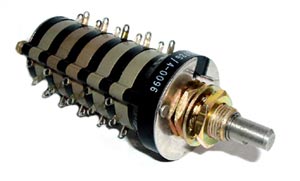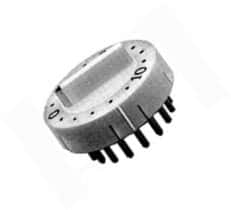DIP or Dual-In-line-Package switches have been popular since the 1970s. OEMs and end-users use them widely to change the functionality of electronic devices at the point of use. For instance, DIP switches allow users to set region codes for equipment to make them work in different areas, to change to a specific radio channel, which garage door the opener will engage, or to select the type of memory a PC motherboard has.
The DIP switch comprises a set of switches within a single unit, typically mounted on a PCB. Each switch is very basic in construction and functionality. The user must set each switch manually, and therefore, the user can simply determine the status by viewing the switch bank during system startup. This is in direct contrast to a membrane keypad connected to a microcontroller, which must be powered up and polled to know the status. Therefore, DIP switches have the simplicity and provide input to basic system firmware, and need not be powered up to know their current status.
Users can select the number of operations on their DIP switch depending on the configuration of the electronic application. This is possible as DIP switches are available in a variety of sizes, configurations, power ratings, and styles.
Just like any other switch, users can select from the number of poles and throws the DIP switch must-have. For instance, they can use the SPST switch or single pole single throw switch, as it has a two-terminal option, with the pole either engaging with the throw to enable continuity or disengaging with the throw to enable electrical isolation.
Likewise, there are SPDT switches or single pole double throw switches, where the user may push the single pole to engage with any one of the throws, and push it the other way to engage with the other throw. It is possible to direct any signal on the pole to either one of the throws at any time.
Other switches are available as a combination of the above SPST and SPDT arrangements. For instance, there may be mechanically linked double poles engaging with double throws, making the switch DPDT or double pole double throw type.
Typically, the number of switches in a package is dependent on the application, with 1 to 16 positions being a common number. For instance, a common DIP switch package may have eight positions, allowing it to be set to 256 different ways. This is equivalent to the 256 binary values that an eight-bit byte may express.
Mechanically, DIP switches are available in various types, depending on the way they operate, whether they have slide actuators, rotary actuators, piano actuators, and so on.
DIP switches with slide actuators usually have two positions, either closed or open, acting as an SPST switch. However, there can be DIP switches with slide actuators and three positions. Frequently, in such switches, the middle position acts as the neutral. As the actuator moves to either side, it makes contact with the position on that side.
DIP switches are low-cost, flexible, and provide a simplicity rarely found.



 Here are some other uses:
Here are some other uses: